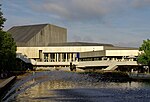Karlsruhe Synagogue
Buildings and structures in KarlsruheEgyptian Revival synagoguesEuropean synagogue stubsFormer synagogues in GermanyGerman religious building and structure stubs ... and 1 more
Religious buildings and structures in Baden-Württemberg

The 1798 Karlsruhe Synagogue was an early building by the influential architect Friedrich Weinbrenner in the city of Karlsruhe. According to David Brownlee, this "synagogue was the first large Egyptian building to be erected since antiquity." According to Diana Muir Appelbaum, it was "the first public building (that is, not a folly, stage set, or funeral monument) in the Egyptian revival style." Appelbaum writes that the pair of tall pylons are copied from the temple at Karnak. The structure stood until 1871.
Excerpt from the Wikipedia article Karlsruhe Synagogue (License: CC BY-SA 3.0, Authors, Images).Karlsruhe Synagogue
Kaiserstraße, Karlsruhe Innenstadt-Ost
Geographical coordinates (GPS) Address Nearby Places Show on map
Geographical coordinates (GPS)
| Latitude | Longitude |
|---|---|
| N 49.009722222222 ° | E 8.4086111111111 ° |
Address
Kaiserstraße 34
76133 Karlsruhe, Innenstadt-Ost
Baden-Württemberg, Germany
Open on Google Maps











